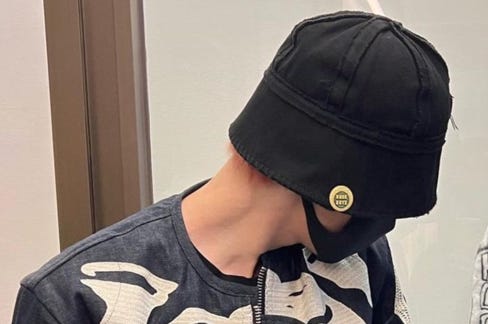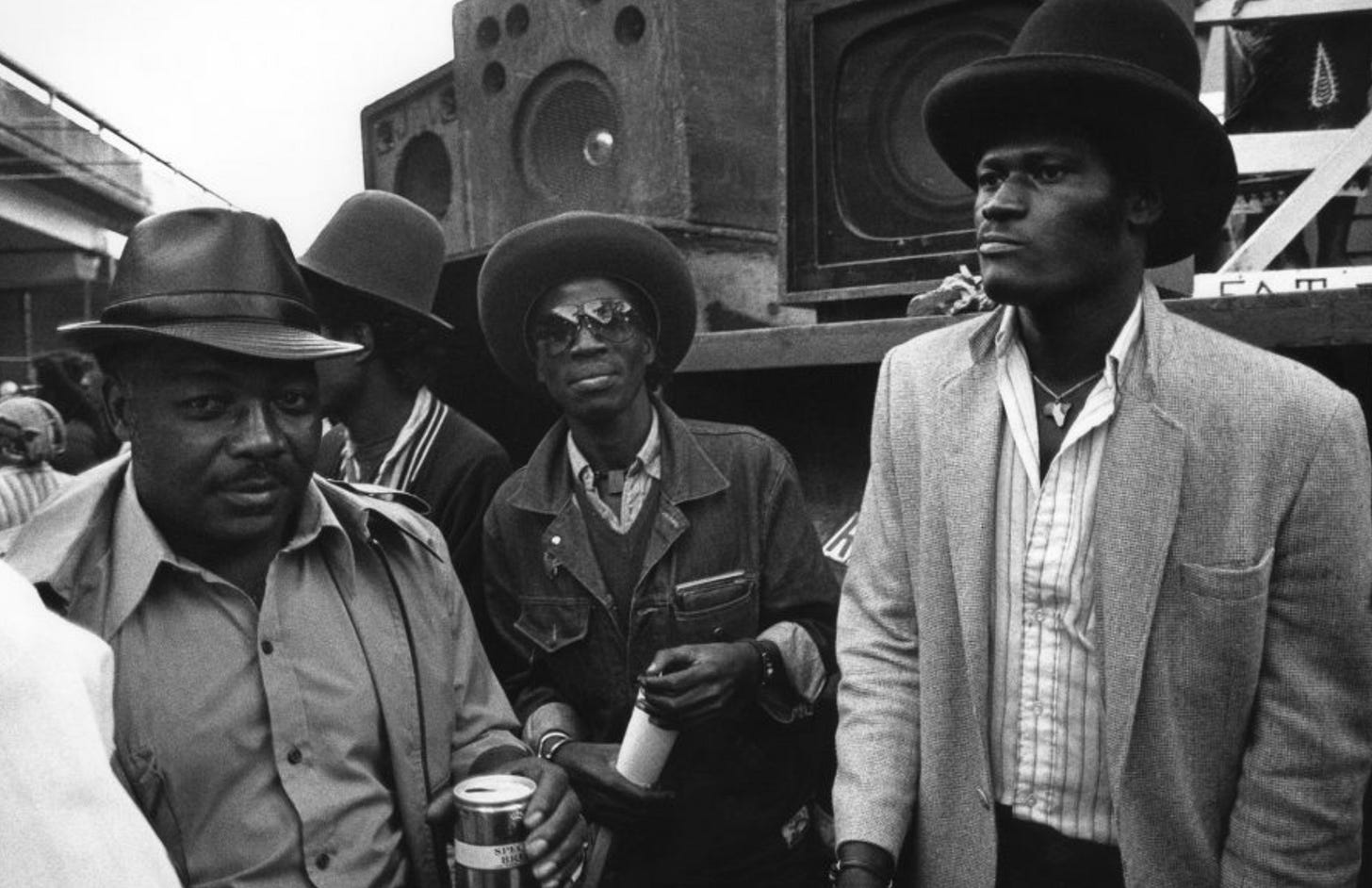The curious case of the 'Rude Boy'....
Taeyong wearing a St. Laurent 'Rude Boys' pin, showing a Rude Boy tattoo and once again, wearing a vintage 'Rude Boys' pin, has sparked a cascade of curiosity about what it all means.....
Taeyong first showed us his penchant for the ‘Rude Boys’ by wearing a black beanie with two very clear pins back in November 2021. One was a black and white wedge pin, and the other displaying the checkerboard background with the words ‘Rude Boys’ on it. To many, this was merely a St. Laurent pin worn by Taeyong because he’s… Taeyong. He likes and can afford to wear big label brands. However to many others who know the origins of the ‘Rude Boy’ checkerboard, this was quite a unique display.
The pins are by St. Laurent and Taeyong choosing to display them on his black beanie was just another way for him to express his fashion forward self. However, once Taeyong displayed the same ‘Rude Boy’ design as a tattoo on his right shoulder at the NCT 127 The Link concert in December 2021, fans started to wonder. Many wondered whether the tattoo was a sticker or a permanent tattoo and much discussion flooded Twitter regarding this. Many were mortified that he would tattoo this on his body. Others questioned whether tattooing a St Laurent pin on his body was a wise move. Others hoped it was temporary and only for the Moonlight performance at the concert. Some loved it and thought it was unique and brazen. As for me, I saw something very different.
Real or fake was of no consequence. It was the motive behind this that was of most interest to me. Did Taeyong really know who the Rude Boys were? Did he understand the origins of the black and white checkerboard logo? Did he actually know ska music and Jerry Dammers who founded Two Tone Records? These questions were racing through my mind. As a musically curious individual, it wouldn’t have surprised me if Taeyong had actually researched the origins of the Rude Boy logo and the entire subculture that surrounded it. He is interested in music, fashion and art and when these combine to form a subculture, I am certain Taeyong would be interested to learn more about them. We have to keep in mind that he has watched ‘Sid and Nancy’ and whilst it is primarily about the explosive relationship between Sid Vicious, Sex Pistols frontman and his girlfriend Nancy, the film does delve into the subcultures present in London in the late 70s- primarily punk and but also the ska movement and Rude Boys as well.
Fast forward to January 2022, and Taeyong was seen sporting yet another ‘Rude Boys’ pin on his bucket hat whilst visiting his artist friend Novo’s solo exhibition. This time, the pin appears to be a vintage pin- not connected to any big name brand.
This is effectively the third time Taeyong has been seen displaying a ‘Rude Boy/s’ logo on his person- twice as pins on hats and once as a sticker/tattoo on his shoulder. The question to ask now is what exactly Taeyong is trying to communicate with us? Is he aligned with the ‘Rude Boys’ subculture from the UK? Does he simply like the logo and thinks it’s unique? Does he actually like Two Tone music associated with reggae/ska/punk? Has he actually heard of The Specials, The Beat and Madness? If not, I really suggest he do so asap. Because displaying this logo with limited understanding of its origins would be facile. But knowing Taeyong, this would be impossible. Everything he does is thought out meticulously. He researches everything he does. He understands music and fashion and art and would not be so flippant to display items, especially on his body, without any understanding of their provenance. So I will conclude that Taeyong does know who the ‘Rude Boys’ are, and feels aligned to them in some way. I won’t assume to know in what way, just that he is clearly, a fan!
So, who were the ‘Rude Boys’? Where did they come from? What do they represent? And how can someone like Taeyong ever see himself as someone who is ‘rude’ when he is the most polite and well mannered man out there?
Origin of the Rude Boys
As an Australian, I spent many nights out at gigs listening to Specials cover bands in Melbourne. I was effectively loosely part of a subculture that was very much about ska and skins. Many in my close circle were skinheads (NOT Nazi skinheads this must be clearly understood) and psychobillies. Amongst all however, was a true appreciation for ska. Music that evolved from dance hall, rocksteady and reggae into the two tone sound made famous by the Specials, Madness and the English Beat. Two decades (!) later, I find myself living in the home of the original ‘Rude Boys’- Jamaica. In some strange twist of serendipity, Taeyong’s fascination with the ‘Rude Boy’ logo is now the centre of discussion simultaneously as I’m now rediscovering ska and the ‘Rude Boys’ in their country of origin.
The Rude Boys originally came from Jamaica. They were poor, unemployed, living in the shanty towns of Kingston and generally got themselves into trouble as a result of their discontent with life post Jamaican independence in 1962. Not surprisingly, Rude Boys were gang members forging a life for themselves in a parallel economy/world- they were street smart and quick witted, having to fend for themselves in a newly independent Jamaica that promised a lot and delivered very little to the poor. Many Jamaicans emigrated to the UK in the post war years, and became known as the ‘Windrush’ generation spanning 1948 -1970. Some of these poor Jamaicans, sought a life in the UK, which promised them work and a future.
The ‘Rude Boy’ now evolved into a complex character- sons and daughters of Jamaican and West Indian immigrants in the UK. These children were British citizens but felt alienated from the mainstream culture at the time- some left Jamaica very young and others, had never even been there, so quintessentially were 2nd generation children trying to find an identity.
In 1960s Britain, Mods and Teddy Boys were predominant in the mainstream culture. They were however, largely associated with ethnically white Brits of the middle classes. The children of Jamaican immigrants, and other working class British kids, couldn’t connect. Here is where the Rude Boys and Skins began to emerge- from the working class slums of London, Birmingham, and Coventry.
Fashion was a crucial identifier for these new subcultures. Just like the Mods and Teds wore Fred Perry and Chelsea boots, the Rude Boys made fashion an important part of their identity. The uniform was a trilby or pork pie hat, tonic suits, blazers, and brogues. The look was classically American jazz and Hollywood bad boy- gangsters in pristine hats and suits.
The Rude Boy culture quickly developed and merged with the existing mod culture of the working classes and another emergent subculture- the Skins. Skinheads were largely white urban working class youth, disaffected by 1960s Britain looking for an identity. They were identified by their ‘Oi’ boots, rolled up jeans, shaved heads, white T shirts and braces. In a type of working class solidarity, Skins and Rude Boys found a niche interacting in the working class burbs of inner London and Coventry. In fact, it was a Rude Boy band that wrote and produced a track entirely for the Skins to enjoy- a Rude Boy track of their own called “Skinhead Moonstomp”.
Initially the skinheads were avid fans of ska, rocksteady and reggae however later in the 70s, became more entrenched in their dissatisfaction with British immigration policies and become more racist and nationalist in their approach. Here is where they parted ways with the Rude Boys. Violence between the two groups grew and become racist in nature. Eventually, the working class dissatisfaction with politics and the economic malaise of late 1970s Britain evolved into the punk movement and then the 2 Tone ska movement. That said, one cannot deny the important role the ‘Rude Boys’ played in its development.
According to Sophie Thompson, it was the 2-Tone movement which “…revitalised the slick swagger of the original Rude Boy.”
It included multi racial bands such as The Specials, Madness and The Selecter all signed on with Two Tone Records, created by Specials’ frontman Jerry Dammers. And here we get to the origins of the Rude Boy logo- a checkerboard pattern in black and white symbolizing a “..fusion of white punk and black ska….”. The checkerboard pattern was coupled with a man in a black suit, white shirt, pork pie hat and loafers. Graphic designer John Sims’ monochrome drawing of a Rude Boy was based on a photograph of Peter Tosh of The Wailers, and in turn, the Wailers’ image was inspired by a photo of Curtis Mayfield’s group, The Impressions: the cyclical references of subculture are ever recurring.4
Perhaps the best quote that encapsulates what it meant to be a ‘Rude Boy' in late 1970s and early 1980s Britain was the following:
“It was the infectious rhythms: the pumping bass; the dual chopping guitars, and the deadpan vocals. The dapper outfits: 3-button jackets, ankle-cut Sta-Prest trousers, pork-pie hats and black brogues. But most of all it was the songs; talking of teenage pregnancy and violence on the streets; of ghost dances and red radios; and calls for Black and white to unite; clothes, music and social politics wrapped up in a British youth movement that landed on Top of the Pops and swept through the school playground.
I sketched my own 2 Tone man on the school walls, imagined myself at the Nite Klub and blushed at the thought of p*** stains on my shoes. I learnt about the imprisoned Nelson Mandela, the horror of rape and bombs dropping on Beirut. 2 Tone carved a deep groove in my soul and thanks to the oxygen of airplay on Radio 1, the mind-blowing visuals of Dance Craze and the glossy pages of Smash Hits my black-and-white world was ignited with a life-affirming blast of colourful brilliance.
Born into 2 Tone. Grown-up a rude boy.”
— Daniel Rachel
Author of Walls Come Tumbling Down (Winner of the Penderyn Music Prize)5
Rude Boys are seeing a revival in terms of their swagger and confidence. It’s more than the music today. It’s more than the fashion today. It’s about a way of being that channels the inner rebel - a confident exterior that is sophisticated, intelligent and dapper.
Jamaica's Rude Boys are back!
For some more detailed information regarding the Rude Boys, check out the Museum of Youth Culture, England.
If you’re interested in finding more about 2- Tone and music inspired by the ‘Rude Boys’, check out the following artists:
https://underground-england.com/the-story-of-subculture-the-rude-boy-rude-girl/
https://underground-england.com/the-story-of-subculture-the-rude-boy-rude-girl/
https://underground-england.com/the-story-of-subculture-the-rude-boy-rude-girl/
https://underground-england.com/the-story-of-subculture-the-rude-boy-rude-girl/
https://culturespacecoventry.com/two-tone
https://culturespacecoventry.com/two-tone













Fabulous article!